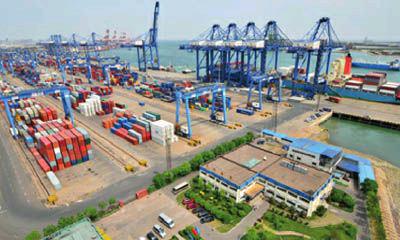FTZ 2.0
2014-12-01ByZhouXiaoyan
By+Zhou+Xiaoyan
A plan to set up a free trade zone (FTZ) in north Chinas Tianjin Municipality has reportedly been approved by related ministries and is awaiting the final go-ahead from the State Council. Covering an area of 64.5 square km, the new Tianjin FTZ will be twice as large as the Shanghai FTZ.
It will be divided into the Dongjiang Bonded Port Zone, Tianjin Port Bonded Zone and central business district in east Tianjins Binhai New Area. Modern logistics, shipping, storage and goods trade will develop based on the two ports, while Binhai New Area will serve as a platform for the development of financial industry and service trade.
Tianjin submitted the FTZ plan in July 2013, following the approval of the Shanghai FTZ. The plan stated that local government would invest up to 60 billion yuan ($9.8 billion) within five years to reclaim land from the sea and expand the area of the Dongjiang zone, according to media reports.
“The original plan only included the Dongjiang port zone. The State Council then replied that the FTZ could expand its area for future development,” a source close to the Tianjin Municipal Government told financial news agency AAStocks.
In October, the State Council approved the expansion of Tianjin Port, with an added 1,120 square km of new water area and more than 70 new berths. Its reported that the expansion plans also laid a solid foundation for Tianjin to explore the opportunity to set up an FTZ.
On October 27, Chinese President Xi Jinping said the Shanghai pilot FTZ reforms can bear fruit elsewhere. “The model behind the pioneering China (Shanghai) Pilot Free Trade Zone should now be copied at other suitable sites across the country where conditions are ripe,”Xi said at a central conference on comprehensively bolstering reform.
Zhang Jianping, a research fellow with the Institute for International Economic Research under the National Development and Reform Commission, forecasted that Tianjin will very likely become the first FTZ in north China.
Bai Ming, a research fellow with the Chinese Academy of International Trade and Economic Cooperation (CAITEC), said the whole point of establishing an FTZ is to further open up to the world.
Tianjin is not the only section that is trying to grab a piece of the pie from the FTZ trials taking place throughout the country. Coastal provinces, including Guangdong and Fujian, are among the most likely sites to host the next batch of FTZs.
The national expansion of FTZ model follows the dazzling achievements of the oneyear-old Shanghai FTZ.
The 29-square-km zone in the Chinese financial hub promises free trade, greater finan-cial openings and fewer government controls over business activities.
Spurred by the zones auspicious outlook, over 12,000 businesses have registered in the Shanghai FTZ during the past year, more than all the companies set up in Shanghais bonded areas during the past two decades. The Shanghai FTZ has introduced a total of 21 innovative administrative measures that could be duplicated elsewhere in the country: six in investment management, six in financial innovation and nine in trade promotion.
Different from Shanghai
Bai believes that Tianjin will actively seek to take advantage of its singular position in the next round of FTZ-driven development.
“With the integration of Beijing, Tianjin and Hebei Province, more and more resources will be mobilized to give more chances to Tianjin FTZ,” Bai said.
“Tianjin FTZ will focus on international shipping and the city will become an international shipping center in north China,” said Zhang Jianping, who also thinks the FTZ will play an enormous role in promoting the development of the private economy in Tianjin.
“The Tianjin FTZ will replicate some of Shanghai FTZs successful reform measures but will also develop its own path for the facilitation and liberalization of investment and trade, because Tianjin has more state-owned enterprises than Shanghai, and development of its private economy, especially its modern service industry, lags far behind that of Shanghai,” the source close to the Tianjin Municipal Government told AAStocks.
“A consensus has been reached that financial reforms in Tianjin FTZ wont attempt to completely replicate Shanghais experience. Tianjin will emphasize on innovative financial measures such as offshore finance,”another source close to the Tianjin Municipal Government told Shanghai Securities News under the condition of anonymity.
“Above all, each region should create its own version of FTZ according to local conditions,” the source said.
More to come?
More than 20 provinces and cities prioritized the development of FTZs in their government work reports this year. Despite little possibility of success, some local governments have already cut red tape and pushed forward reforms in preparation for an application.
Experts have suggested the second batch of FTZs should have features distinct from Shanghai and from each other—homogeneous FTZs would mean a failure of the nationwide expansion. Some experts also cautioned against the over-development of FTZs throughout the country, adding that some cities attempts to apply for favorable policies might run contrary to the original intention of FTZs.
Zhou Hanmin, Vice Chairman of the Shanghai Municipal Committee of the Chinese Peoples Political Consultative Conference, said that new FTZs should have their own distinctive functions aimed at pushing forward their own specific economic reforms and policies.
“Guangdong should focus on its economic cooperation with Hong Kong and Macao, and Fujian should focus on its ties with Taiwan, while Tianjin will mainly emphasize its role in the Silk Road Economic Belt,” Zhou said.
Chen Bo, Deputy Director of the Research Center on Free Trade Zone under the Shanghai University of Finance and Economics, said if there is only one FTZ in China, people cant tell whether reforms are good enough or fast enough.
“Thats why China needs more FTZs,” Chen said. “Competition among FTZs will generate more efficiency. But it shouldnt lead to vicious competition. So its okay to have several FTZs in China, but not too many.”
“Shanghai FTZ will be the only one in the country thats a comprehensive FTZ, while new FTZs will be specialized in specific areas. For instance, Tianjin FTZ will focus on international shipping and financial lease,” Chen said.
Zhang Li, a researcher with the CAITEC, said FTZ trials will push forward economic growth amid a nationwide economic slowdown and a lack of growth engines.
“Many regions want to use preferential policies of FTZs to lure foreign investment and promote local economic growth. This is the biggest benefit,” Zhang Li said.
“From a national point of view, setting up FTZs represents an inevitable trend. China has three economic circles—the Yangtze River Delta, Pearl River Delta and Bohai Economic Rim, in line with the existent FTZ and possible future FTZs in Shanghai, Guangdong and Fujian and Tianjin,” Zhang Li said. “Setting up FTZs in these regions will greatly lift regional economic growth.”
